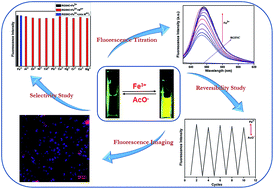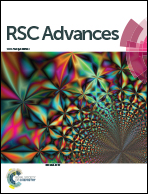Remarkably selective biocompatible turn-on fluorescent probe for detection of Fe3+ in human blood samples and cells†
Abstract
The robust nature of a biocompatible fluorescent probe is demonstrated, by its detection of Fe3+ even after repeated rounds of quenching (reversibility) by acetate in real human blood samples and cells in vitro. Significantly trace levels of Fe3+ ions up to 8.2 nM could be detected, remaining unaffected by the existence of various other metal ions. The obtained results are validated by AAS and ICP-OES methods. A portable test strip is also fabricated for quick on field detection of Fe3+. As iron is a ubiquitous metal in cells and plays a prominent role in biological processes, the use of this probe to image Fe3+ in cells is a substantial development towards biosensing. Cytotoxicity studies also proved the nontoxic nature of this probe.



 Please wait while we load your content...
Please wait while we load your content...